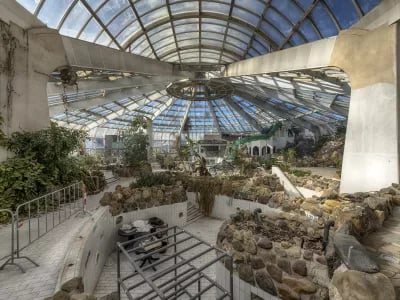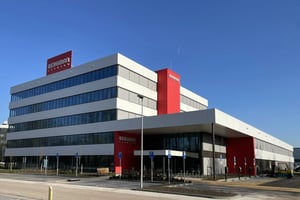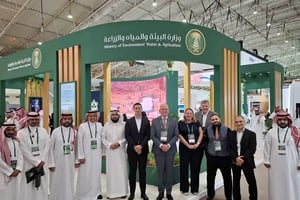For years it was the place to be for a relaxed dip in the pool for Rotterdam locals: Tropicana. Today the former water park is home to a circular sustainable model city called: BlueCity. ‘Blue Economy Officers’ Siemen Cox and Mark Slegers explain how several innovative, sustainable businesses repurposed the 12,000-square-metre vacant property and gave it new functions, value and meaning.
Have you ever come across a book that inspired you to start doing things radically differently? That’s exactly what happened to Siemen Cox, a former independent contractor in the financial services industry, after reading Gunter Pauli’s The Blue Economy. Of the numerous circular economy business cases presented in this book, there was one that he couldn’t get out of his mind: ‘Growing oyster mushrooms on coffee grinds. I had no idea how to go about it. There was no knowledge available and the growers who were experimenting with the technique at the time didn’t want to help me out because they didn’t want any competition. But I was so captivated by the idea that I just decided to do it.’
At a certain point Cox met Mark Slegers, who was employed in the energy sector at the time and who would go on to become his business partner and the co-founder of their company, Rotterzwam. Their aim: to build a healthy business based on something that is universally seen as waste: coffee grounds. The two young entrepreneurs were soon given the go-ahead to temporarily set up their first mushroom farm inside the building that housed the former Tropicana water park. ‘But we soon noticed as a circular business that we were attracting a lot of extra attention because of our unusual location’, says Cox. ‘At a certain point we decided that other circular entrepreneurs deserved the same attention. That’s when the idea for BlueCity was born: a unique ecosystem of companies that rejects the outdated concept of “waste”. So one business’s output is another business’s input.’
Collaboration is the new competition
BlueCity is currently home to ten companies in all, and an investor has helped them to purchase the building. The site is slowly being remodelled and upgraded, making ingenuous use of the building’s varied features and temperatures. As Slegers explains, an algae farm is currently being developed, which will generate large quantities of residual value and will double as a local heat generator in several cold sections of the building. ‘In addition to the various businesses located in BlueCity and which our incubator facilitates and supports, the building itself also qualifies as a sustainable asset. We use sunlight, hydropower, wind power and the purifying effect of plants as primary sources of energy and air-conditioning. This is not restricted to the interior of the building, but also extends to the immediate vicinity. These resources enable us to purify the local air using green moss panels that absorb particulate matter.’
The aim is for the BlueCity businesses to grow organically. Slegers: ‘A lot of the activities here aren’t necessarily planned in advance – they just arise. We notice that this can sometimes be hard to explain to visitors. They want to know what the future holds for us, but the answer is: we don’t know. And if they ask us when the project will be “completed”, the truthful answer is: never.’
Cox draws a parallel with nature – a key concept in the ‘blue’ economic mindset. ‘Just like nature is always changing and offers space for infinite diversity, it’s the same with BlueCity’, he says. ‘Circularity is often about just closing loops, whereas we think more in terms of cascading nutrients, where the output of one process serves as the input for another process. That’s what we try to simulate here and we’ve found this approach helps to create new partnerships between companies almost organically. Since we were already working with coffee waste, we decided to team up with a new company that develops bioplastics based on coffee waste. It was kind of unplanned, but it’s turned out to be a great fit. In that sense, I suppose, collaboration really is the new competition.’













